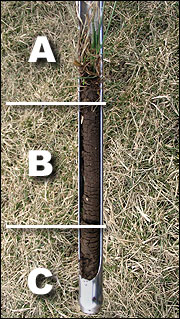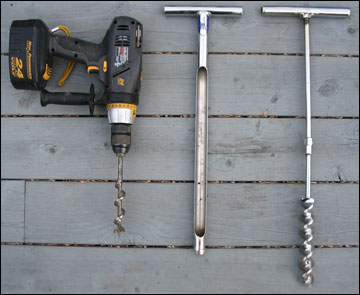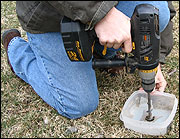Collecting a representative soil sample is an important step in developing a nutrient plan for your farm. The goals of your soil sampling plan should be to
- Identify manageable sized fields with similar characteristics.
- Accurately and cost-effectively determine the nutrient status of those fields.
Highly variable soil fertility levels across a field can make it difficult to collect a good soil sample. With planning, representative soil samples can be obtained from your pasture. Careful, comprehensive soil sampling pays dividends in smarter management decisions and efficient use of fertilizer nutrients.
How should I divide my pastures?
When creating a soil-sampling plan for fields and farms, the objective is to divide fields into areas that you expect to have similar characteristics or that you are likely to manage differently than other parts of the pasture. Typically sampling areas should not exceed 20 acres and can be much smaller. In management-intensive grazing systems, frequently the best strategy is to sample each paddock separately.
Pastures have many sources of variability:
- Animal activities and habits are a huge source of variation in pastures.
- Areas around winter feeders, shade trees and water sources have higher soil test levels.
- Manure piles and urine spots have elevated nutrients.
- Natural features such as soil type and topography are important sources in variability, particularly in low-testing and unfertilized fields.
- Human activities can overwhelm natural sources of variability in a field.
- Nutrient hot spots are often found near old feeding areas and homesteads.
- Differences in fertilizer patterns can create differences in soil test levels. An indicator of different fertilizer histories can be old or existing fence lines.
- There is often a band of elevated pH within 150 feet of a gravel road caused by drifting dust from the crushed limestone road surface.
When sampling a paddock or field, avoid sampling in areas that are unrepresentative of the field (Figure 1). Avoid taking cores near shade trees, water sources and winter feeding areas. If you want to know soil test levels in these areas, sample them separately.
How to collect a soil sample
Your objective is to collect 15 to 20 cores from the area to be sampled (Figure 1). You need to collect more cores per field in a pasture than in a row-crop field because there typically is much more variation in a pasture from manure piles and urine spots.
The best approach is to travel across the entire area to be sampled in a zigzag pattern, randomly selecting spots to take a core (Figure 1). Sampling depth is 6 to 7 inches for most objectives in pastures (Figure 2). Do not take too shallow a sample as this will overestimate the soil fertility level in your pasture.
 Figure 1
Figure 1
Obtaining a quality soil sample.
 Figure 2
Figure 2
Obtaining a 6- to 7-inch core for soil sampling.
A. Discard organic duff on top of soil.
B. Put 6- to 7-inch soil core in sampling bucket.
C. Discard soil below 6 to 7 inches.
 Figure 3
Figure 3
Coring devices are best for soil sampling. Augers are recommended on rocky soils. Hand samplers at least 3 feet long are desirable because they reduce back strain.
 Figure 4
Figure 4
A power drill facilitates sampling in rocky or dry soils. Use a plastic container with a hole in the middle to collect the soil as the auger pulls it out of the ground. Empty the soil out of the plastic container into the soil sample bucket after each successful attempt to get a 6-inch core.
Needed equipment for soil sampling includes
- A soil sampler; preferably some type of coring device.
- A clean plastic bucket; e.g., plastic paint bucket.
- A small box or bag; contact your soil testing lab for boxes. Hardware store nail bags work well.
- Map of the field with sampling plan and sample labels.
The best tool for soil sampling is a coring device (Figures 3 and 4). A core sampler works best in soils with few rocks. In rocky soils, some type of auger is the preferred tool. If you are doing a lot of sampling, a power drill with an auger can be efficient. A shovel or spade can be used if a coring device is not available.
Always use clean equipment when collecting soil samples. A plastic bucket should be used for collecting and mixing samples.
It is best to wait at least three months after application of phosphorus fertilizer, lime or manure before taking a soil sample. Sample your pasture every three to five years. It is better to do a more thorough job of sampling with more cores per sample less often than to do a poor job more often. It is also best to sample fields at the same time of year each time you sample.
Avoid sampling near fresh manure piles or recent urine spots. These areas do not represent the bulk of the paddock. It is appropriate to sample in or near older manure piles and urine patches in intensively grazed pastures with a high amount of manure coverage.
Submitting your soil samples
Break up the 15 to 20 cores and thoroughly mix the soil. Place about 1.5 cups of the mixture into a soil sample box or plastic bag and discard the excess. If the soil is too wet to mix thoroughly, the sample can be set out on a bench and allowed to air dry before mixing.
Label the sample with field and subfield names. Soil sample boxes and soil information forms can be obtained from private soil testing labs or your local MU Extension center or by contacting:
- Soil and Plant Testing Laboratory
23 Mumford Hall
Columbia, Mo. 65211
extension.missouri.edu/programs/soil-and-plant-testing-laboratory/spl-soil-analysis
Soil samples can also be submitted to your local MU Extension center or directly to a University or private soil testing lab. Be sure to use a lab that has been accredited by Missouri Soil Testing Association (MSTA). extension.missouri.edu/programs/soil-and-plant-testing-laboratory/spl-missouri-soil-accreditation-program